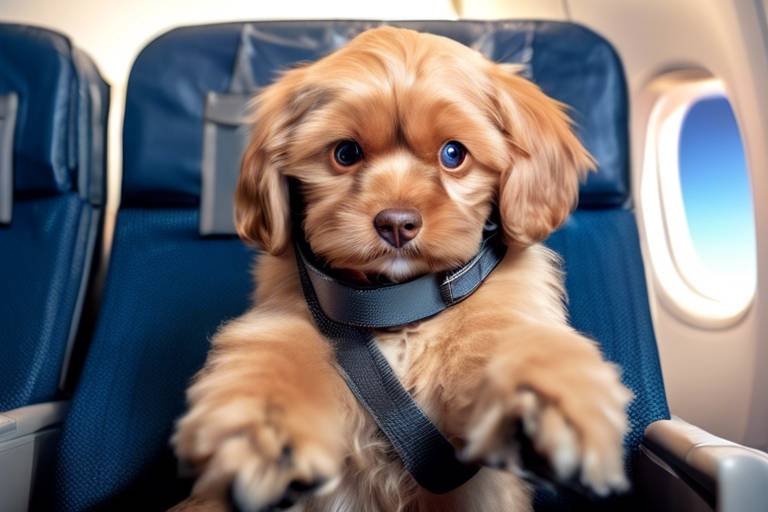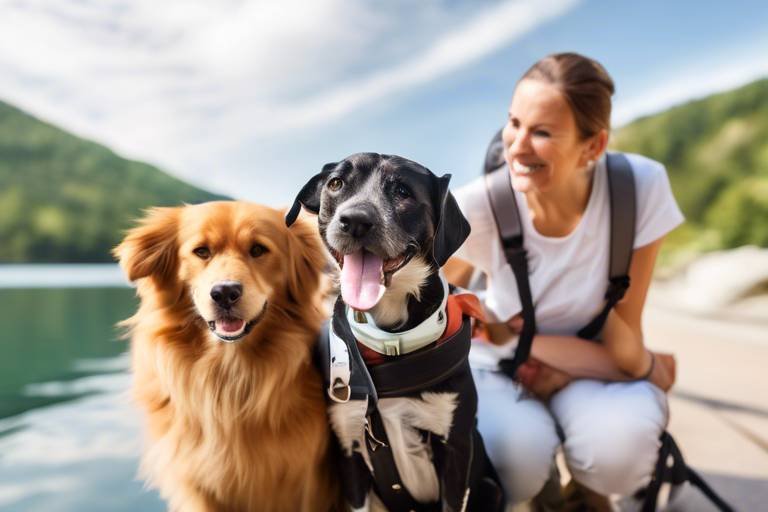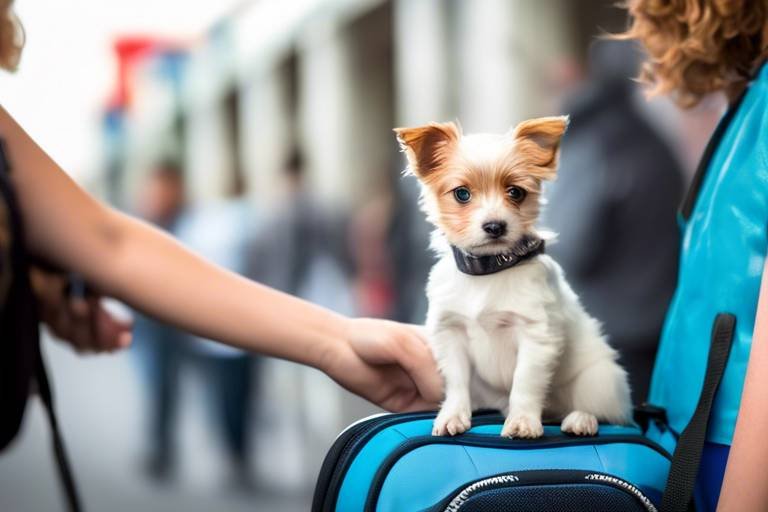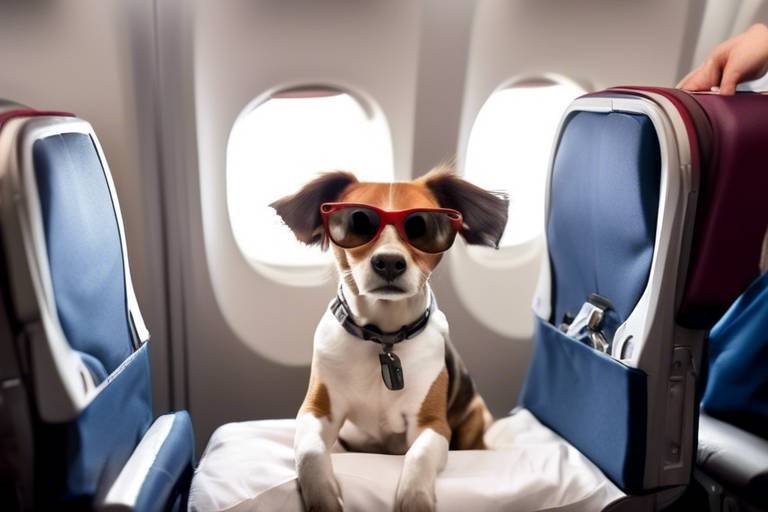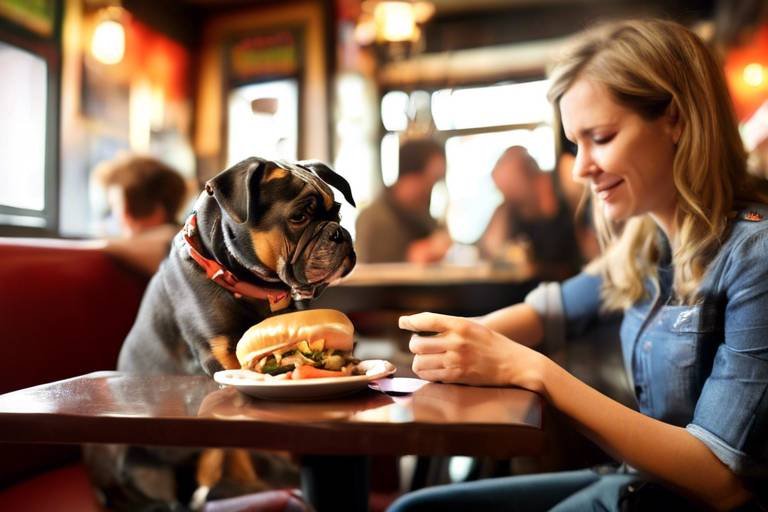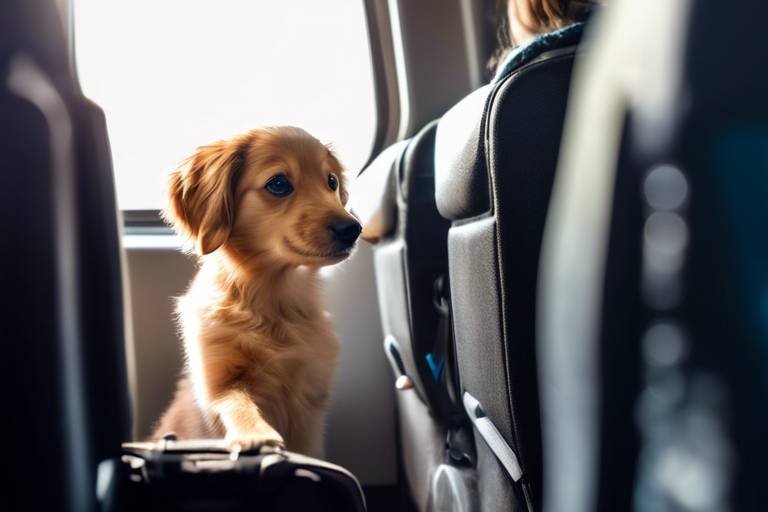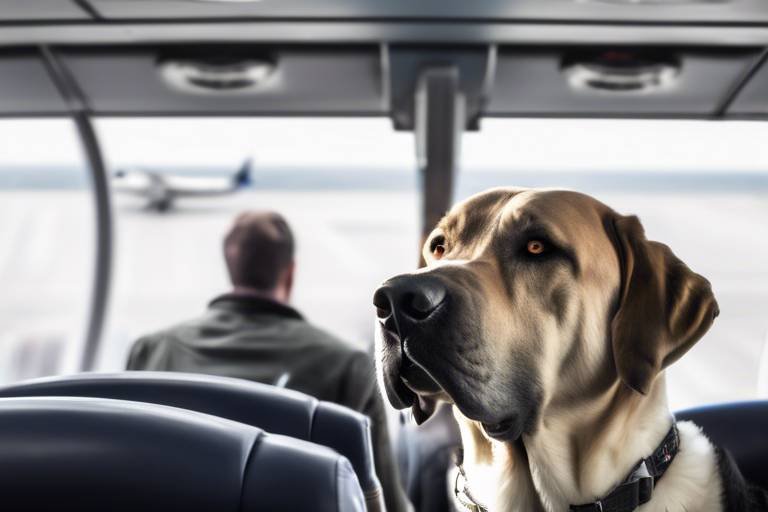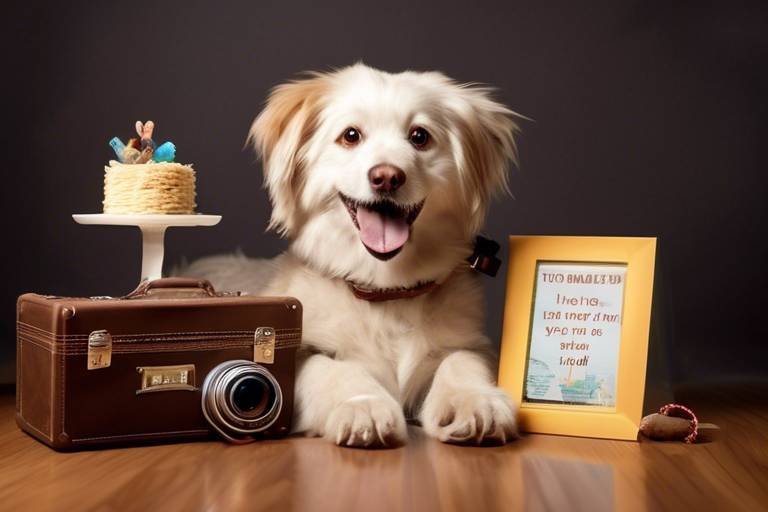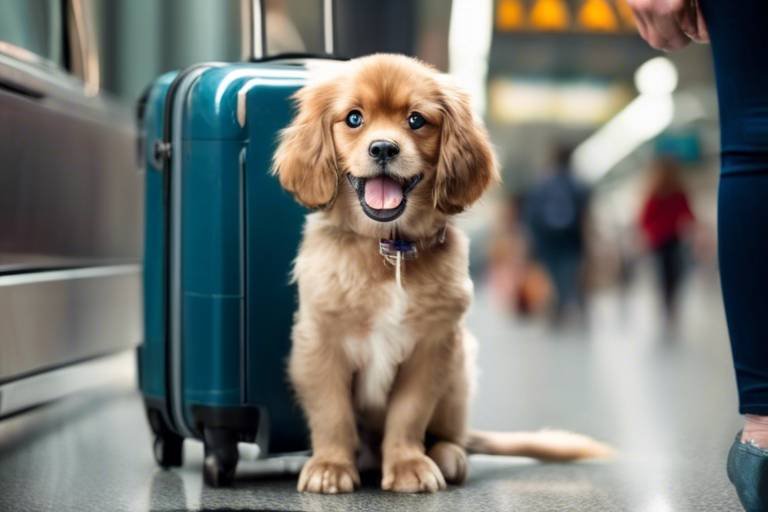How to Keep Your Pet Entertained on Long Flights
Traveling with your pet can be a delightful adventure, but it also comes with its own set of challenges, especially when it involves long flights. Imagine being cooped up in a confined space for hours on end—it's not just humans who can feel restless and anxious. Just like us, our furry friends can experience stress and boredom during air travel. So, how do we keep our beloved pets engaged and calm while soaring through the skies? In this article, we’ll explore effective strategies that will not only enhance your pet's travel experience but also reduce stress for both you and your four-legged companion.
Before you even think about packing the travel carrier, it's essential to recognize the specific needs of your pet. Every animal has its own personality, quirks, and preferences, and understanding these can make a world of difference in planning for their entertainment during flights. For instance, does your pet thrive on interaction, or are they more of a lone wolf? Consider their temperament—are they naturally anxious, or do they take things in stride? By assessing your pet's behavior, you can tailor your approach to keep them engaged. For example, a playful pup might enjoy a game of tug-of-war with a travel-friendly toy, while a more reserved cat might prefer a cozy blanket and a few treats to nibble on.
The travel carrier you select plays a significant role in your pet's comfort and engagement during the flight. Not all carriers are created equal, and choosing the right one can make a huge difference. Look for features that promote entertainment and safety. Here are some key aspects to consider:
When it comes to carriers, size matters! Your pet should be able to sit, stand, and turn around comfortably inside their carrier. A cramped space can lead to discomfort and restlessness, making the journey even more stressful. Make sure to measure your pet before purchasing a carrier. A well-fitted carrier not only provides comfort but also allows your pet to move around a bit, which can help ease anxiety.
Good ventilation and visibility are crucial for your pet's well-being during the flight. A carrier with ample airflow will help keep your pet cool and comfortable. Additionally, being able to see out of the carrier can help your pet feel more secure. Imagine being in a dark room with no idea what's happening around you—it's unnerving! A carrier with mesh panels or windows allows your pet to observe their surroundings, which can be soothing.
Let’s face it: accidents happen. A durable and secure carrier ensures your pet's safety during travel. Look for carriers made from sturdy materials that can withstand the rigors of travel. Features like locking mechanisms and reinforced seams provide peace of mind for pet owners. After all, the last thing you want is to worry about your pet escaping in an unfamiliar environment!
Now that you've got the right carrier, it's time to think about entertainment! Bringing along engaging toys can keep your pet entertained throughout the flight. Opt for travel-friendly toys that are lightweight and easy to pack. Think of toys that stimulate your pet's mind, such as puzzle toys filled with treats or interactive toys that encourage play. Not only do these toys keep them busy, but they also help reduce anxiety by providing a distraction.
Incorporating calming techniques can greatly help in easing your pet's anxiety during flights. Just like humans, pets can benefit from a little relaxation. Consider bringing along familiar items, such as a favorite blanket or a piece of your clothing, to provide comfort. Additionally, there are various methods to keep your pet relaxed and entertained.
Did you know that playing soothing music or sounds can create a calming environment for your pet? Many pets respond positively to gentle sounds, which can help reduce stress during travel. There are even playlists specifically designed for pets! Choose calming music or nature sounds that can help drown out the noise of the airplane, creating a serene atmosphere for your furry friend.
Interactive games can be a fantastic way to engage your pet's mind while traveling. Think about simple games that can be played in a limited space, such as hide-and-seek with treats or gentle tug-of-war with a soft toy. These activities not only keep your pet entertained but also strengthen your bond during the journey. Remember, a little playtime goes a long way in keeping spirits high while flying!
- Can I bring my pet on a flight without a carrier? - Most airlines require pets to be transported in an approved carrier for their safety and comfort.
- What types of toys are best for long flights? - Look for toys that are durable, lightweight, and can engage your pet’s curiosity, like puzzle toys or soft chewables.
- How can I help my pet relax before the flight? - Familiarize your pet with their carrier ahead of time, and consider using calming sprays or pheromone diffusers.

Understanding Your Pet's Needs
When it comes to traveling with your furry friend, understanding their unique needs is absolutely essential. Just like us, pets have their own personalities, preferences, and quirks that can significantly influence how they handle long flights. Taking the time to assess your pet's temperament can be the difference between a smooth journey and a stressful one. For instance, does your pet thrive on social interaction, or do they prefer solitude? Are they easily startled by loud noises, or are they the adventurous type who relishes new experiences? These questions are crucial to consider before embarking on your trip.
One effective way to gauge your pet's needs is to observe their behavior in different situations. For example, if your dog tends to get anxious during thunderstorms, it’s likely that they will feel similarly during a flight. On the other hand, a cat that enjoys being held and petted might appreciate the closeness of your company during the journey. Understanding these nuances will help you tailor their travel experience to be as comfortable and engaging as possible.
Additionally, it’s important to consider the age and health of your pet. Puppies and kittens are often more adaptable but may require more frequent breaks and playtime. Senior pets, on the other hand, might need extra care and attention to ensure they are comfortable and not overwhelmed. If your pet has any medical conditions, consulting with your veterinarian before traveling is a wise decision. They can provide insights on any special considerations you should keep in mind.
To help you better understand your pet's needs, here’s a quick overview of factors to consider:
- Temperament: Is your pet calm or anxious?
- Age: Are they a young, energetic pet or a senior who requires more comfort?
- Health: Are there any medical conditions that need to be addressed?
- Preferences: Does your pet enjoy toys, or do they prefer your company?
By taking the time to evaluate these aspects, you can create a travel plan that not only keeps your pet entertained but also minimizes their stress. Remember, a well-prepared pet is a happy pet, and that happiness will translate into a more enjoyable experience for both of you. So, as you pack your bags, don’t forget to pack a little extra love and understanding for your furry companion!

Choosing the Right Travel Carrier
Selecting the right travel carrier for your pet is not just about picking something that looks nice; it’s about ensuring comfort, safety, and entertainment throughout the journey. A well-chosen carrier can make all the difference in how your pet experiences the flight, transforming what could be a stressful situation into a more enjoyable adventure. So, what should you look for when choosing a carrier? Let’s dive into the essential features that will keep your furry friend happy and engaged during those long hours in the air.
The size of the carrier is paramount. You want your pet to have enough space to sit, stand, and turn around comfortably. A cramped space can lead to anxiety and discomfort, which is the last thing you want during a long flight. When selecting a carrier, measure your pet's height and length, and ensure the carrier provides at least a few extra inches to accommodate their movements. Generally, carriers should be at least 1-2 inches taller than your pet's height when standing and long enough for them to stretch out. This ensures they can find a comfortable position, whether they prefer curling up or lounging flat.
Good ventilation is another critical factor in choosing a travel carrier. Your pet needs fresh air and a chance to see their surroundings to feel secure. Look for carriers that feature mesh panels or ventilation holes that allow for airflow while still keeping your pet contained. This not only helps regulate temperature but also gives your pet a sense of their environment, which can be comforting. Remember, a pet that can see what’s going on around them is less likely to panic. When they can peek out and see you, it fosters a sense of connection and reduces anxiety.
Durability is essential. You want a carrier that can withstand the rigors of travel. Look for carriers made from sturdy materials that can handle the occasional bump or jostle without breaking. Additionally, security features like zippers that can’t be easily opened by curious paws, or clips that secure the door, are important to ensure your pet stays safe inside. A well-constructed carrier not only provides peace of mind for you as an owner but also protects your pet during transit. After all, no one wants to deal with a runaway pet in an airport!
In conclusion, choosing the right travel carrier involves considering size, ventilation, visibility, durability, and security. By taking the time to select a carrier that meets these criteria, you can significantly enhance your pet's travel experience, making it more enjoyable for both of you. Remember, a happy pet means a happy owner!
- What size carrier do I need for my pet? The carrier should be large enough for your pet to stand, turn around, and lie down comfortably. Measure your pet and choose a carrier accordingly.
- Can I use a regular pet carrier for air travel? Not all pet carriers are airline-approved. Always check the specific airline’s requirements before purchasing a carrier.
- How can I help my pet feel comfortable in the carrier? Familiarize your pet with the carrier before the trip. Place their favorite blanket or toy inside to make it feel like home.
Size and Space Considerations
When it comes to choosing the right travel carrier for your pet, size and space are paramount. Just like how we feel cramped and uncomfortable in a tight space, our furry friends can experience the same discomfort. A carrier that is too small can cause anxiety, restrict movement, and lead to a stressful journey. Therefore, it's essential to select a carrier that allows your pet enough room to sit, stand, and turn around comfortably. Imagine trying to enjoy a long road trip while being squished in the back seat—your pet deserves better!
To find the perfect size, you should measure your pet from the tip of their nose to the base of their tail, and from the ground to the top of their head when they are standing. This will give you a clear idea of the minimum dimensions required for the carrier. A good rule of thumb is to add a few inches to these measurements to ensure your pet has enough space to move around. Here’s a simple table to help you with the sizing:
| Pet Size | Recommended Carrier Dimensions (L x W x H) |
|---|---|
| Small (up to 10 lbs) | 18" x 12" x 10" |
| Medium (10-20 lbs) | 24" x 16" x 14" |
| Large (20-30 lbs) | 30" x 20" x 20" |
| X-Large (30-50 lbs) | 36" x 24" x 24" |
Additionally, consider the carrier's design. Some carriers come with adjustable partitions or removable bases, allowing you to customize the space according to your pet's size. This flexibility can be beneficial, especially if you have a growing puppy or kitten. Not to mention, a well-designed carrier can also make it easier for you to manage your pet's space, ensuring they are comfortable throughout the flight.
Don't forget to think about the weight of the carrier itself! A heavy carrier may seem sturdy, but it can be cumbersome to carry, especially if you have to navigate through busy airports. Lightweight materials that still offer durability are ideal. Ultimately, the right carrier should feel like a cozy little den for your pet, rather than a confining cage. After all, a happy pet makes for a happy travel experience!
Ventilation and Visibility
When it comes to traveling with your furry friend, are two critical factors that can greatly influence their comfort and overall experience during a flight. Imagine being cooped up in a small, stuffy space without the ability to see what’s going on outside—you’d feel anxious, right? The same goes for your pet. A carrier that allows for adequate airflow is essential. It ensures that your pet can breathe easily while also keeping them cool. Look for carriers that have mesh panels or multiple ventilation holes, allowing fresh air to circulate freely.
Visibility plays an equally important role. Pets are naturally curious creatures, and being able to see their surroundings can help reduce anxiety. If they can peek out and observe the world around them, they are less likely to feel trapped. Choose a carrier that has clear windows or openings that allow your pet to gaze outside. This not only keeps them entertained but also provides a sense of security. You might even consider carriers with a transparent top, giving your pet a panoramic view while still being safely secured inside.
Moreover, ensuring that your pet feels comfortable in their carrier can be enhanced by how they perceive their environment. A carrier with both ventilation and visibility can help your pet feel less isolated and more connected to you. In fact, many pet owners report that their animals are much calmer and more relaxed during flights when they can see their owners or the outside world. So, when selecting a travel carrier, be sure to prioritize these features. It’s not just about moving from point A to point B; it’s about making the journey enjoyable for your beloved pet.
In summary, when considering the right carrier for your pet, remember these vital points:
- Airflow: Ensure there are enough ventilation holes or mesh panels.
- Visibility: Look for carriers with transparent sections to allow your pet to see outside.
- Comfort: Choose a carrier that feels spacious enough for your pet to sit, stand, and turn around.
By paying attention to ventilation and visibility, you'll be setting the stage for a more pleasant travel experience, making those long flights a little less daunting for your pet.
Q: How can I tell if my pet is comfortable in their carrier?
A: Signs of comfort include relaxed body language, lying down, and being calm. If they’re pacing or whining, they may need adjustments.
Q: What if my pet gets anxious during the flight?
A: Consider using calming techniques, such as soothing music, and ensure they have familiar toys to help ease their anxiety.
Q: Are there specific types of toys that are best for travel?
A: Yes! Look for lightweight, durable toys that can be easily stored in the carrier and are safe for your pet to play with during the flight.
Durability and Security
When it comes to traveling with your pet, in their travel carrier are non-negotiable. You want a carrier that can withstand the rigors of travel while keeping your furry friend safe and sound. Imagine a carrier that feels like a fortress for your pet, providing them with a cozy and secure environment amidst the chaos of an airport or the turbulence of a flight. Choosing the right materials is essential; look for carriers made from high-quality, tear-resistant fabrics that can endure wear and tear. Additionally, a solid frame is crucial to prevent any accidental collapses that could frighten your pet or cause injury.
Security features are equally important. A reliable carrier should have robust locking mechanisms to ensure your pet doesn't accidentally escape during transit. Think of it as a safety net, giving you peace of mind while you focus on your journey. Look for carriers with secure zippers or latches that are easy for you to operate but challenging for your curious pet. Some carriers even come with built-in safety straps that can be attached to your seatbelt, providing an extra layer of security during the flight.
Another factor to consider is the design of the carrier. A well-designed carrier will have reinforced seams and corners, which are often the first places to show signs of wear. A sturdy base is also essential, as it helps maintain the carrier's shape, ensuring your pet has enough room to move comfortably. Think of it as a cozy little apartment for your pet, where they can sit, stand, and turn around without feeling cramped.
Here’s a quick table summarizing the key features to look for in a durable and secure pet carrier:
| Feature | Description |
|---|---|
| Material | Tear-resistant fabrics and sturdy construction |
| Locking Mechanism | Secure zippers or latches to prevent escapes |
| Reinforced Seams | Durable stitching to withstand wear and tear |
| Safety Straps | Straps to secure the carrier to your seatbelt |
In summary, investing in a durable and secure travel carrier is not just about comfort; it’s about ensuring your pet's safety and your peace of mind. With the right carrier, you can transform a potentially stressful journey into a smooth and enjoyable experience for both you and your beloved pet.
- What size carrier do I need for my pet? The carrier should be large enough for your pet to sit, stand, and turn around comfortably.
- Can I use a soft-sided carrier on a plane? Yes, many airlines allow soft-sided carriers, but always check the specific airline's requirements.
- How can I help my pet feel secure in the carrier? Familiarize your pet with the carrier before travel and place their favorite blanket or toy inside.
- Are there carriers designed for larger pets? Absolutely! There are many options available for larger breeds; just ensure they meet airline regulations.
Engaging Toys and Activities
When it comes to keeping your pet entertained during long flights, can make all the difference. Imagine being stuck in a confined space for hours—wouldn't you want something to keep your mind stimulated? Your furry friend feels the same way! It's essential to choose toys that not only capture their attention but also provide a sense of comfort and engagement. Here are some ideas to consider:
First off, interactive toys are a fantastic option. These toys often require your pet to solve a puzzle or figure out how to get a treat, which can keep them busy for quite some time. Look for toys that are specifically designed for travel, as they are usually compact and easy to pack. For instance, treat-dispensing balls can be a great way to reward your pet while also keeping them occupied. Just imagine your pup rolling the ball around, trying to figure out how to get the goodies inside!
Another excellent choice is chew toys. Not only do they help to keep your pet entertained, but they also promote dental health. Opt for durable, non-destructive chew toys that can withstand the excitement of travel. Some toys even come with built-in squeakers or sound features that can pique your pet's interest. Just think of it as bringing a piece of home along for the ride!
Don't forget about comfort items. Sometimes, familiarity is the best entertainment. Bringing along your pet’s favorite blanket or a soft toy can provide them with a sense of security amidst the chaos of travel. It's like having a little piece of home with them, which can be incredibly comforting. You might even consider a travel-friendly bed that can be easily packed and set up in the carrier, giving your pet a cozy spot to curl up during the flight.
In addition to toys, engaging your pet in simple activities can also help pass the time. For example, you can practice basic commands or tricks during the flight. This not only keeps their mind engaged but also strengthens your bond. Just a few minutes of play can make a world of difference. You might say, "Sit!" or "Paw!" and reward them with a treat from your travel stash. It's a win-win!
Lastly, remember to rotate the toys you bring along. If your pet gets bored with one toy, having a few different options can keep their interest alive. Consider packing a small toy bag with a mix of interactive toys, chewables, and comfort items. This way, you can switch things up throughout the flight, ensuring your pet remains entertained and engaged. After all, keeping their spirits high means a more enjoyable travel experience for both of you!
- What types of toys are best for long flights? Look for interactive, chewable, and comfort toys that are travel-friendly and durable.
- How can I keep my pet calm during the flight? Incorporate calming techniques like soothing music, familiar items, and engaging activities.
- Is it okay to bring multiple toys? Absolutely! Rotating toys can help maintain your pet's interest and prevent boredom.

Utilizing Calming Techniques
Traveling with your pet can be a thrilling adventure, but it can also bring about a fair share of anxiety for both you and your furry friend. To help ease this tension, can be incredibly beneficial. Imagine boarding a plane, and instead of hearing the usual whines and barks, you find your pet relaxed and at ease. Sounds great, right? Well, it’s possible! By incorporating a few simple strategies, you can turn a potentially stressful experience into a peaceful journey.
One of the most effective calming techniques is music and sound therapy. Just like humans, pets respond positively to soothing sounds. Playing soft music or nature sounds can create a serene environment, helping to drown out the noise of the airplane. You might wonder, "What kind of music should I play?" Look for playlists specifically designed for pets, as they often include gentle melodies that can help lower stress levels. You can even find apps that feature pet-friendly sounds. Imagine your pet lounging in their carrier, lulled into a relaxed state by the gentle strumming of a guitar or soft piano tunes.
Another fantastic method to keep your pet calm is through interactive games. While space may be limited on a flight, you can still engage your pet’s mind with simple games. Consider bringing along a few small, quiet toys that can be used for interactive play. For instance, a soft plush toy or a puzzle feeder can keep your pet occupied for a while. You can even create a mini scavenger hunt by hiding treats in their carrier. This not only distracts them but also stimulates their brain, making the flight feel shorter and more enjoyable.
Additionally, familiar scents can work wonders in calming your pet. Bringing along a favorite blanket or a piece of your clothing can provide comfort and a sense of security. Pets are incredibly sensitive to scents, and having something that smells like home can make them feel more at ease. Think of it as a comforting hug from you, even when you’re miles away. If you're flying with a dog, consider using calming sprays made from natural ingredients like lavender or chamomile. These scents can create a soothing atmosphere that helps reduce anxiety.
Lastly, don’t underestimate the power of pre-flight preparation. Before you embark on your journey, take some time to acclimate your pet to their carrier. Allow them to explore it at home, and consider taking short car rides to help them get used to being confined for longer periods. The more comfortable they are with their space, the less anxious they will feel during the flight. Remember, a little preparation goes a long way in ensuring a smooth travel experience for both you and your pet.
- What should I do if my pet gets anxious during the flight?
Try to stay calm yourself and use soothing techniques like gentle petting or talking to them in a soft voice. Consider using calming sprays or music as discussed above. - Can I give my pet medication to help with anxiety?
Consult with your veterinarian about whether medication is appropriate for your pet. They can provide guidance on suitable options. - How can I ensure my pet is comfortable during the flight?
Choose an appropriate carrier, bring familiar items, and ensure they have enough space to move around comfortably.
Music and Sound Therapy
When it comes to keeping your pet calm during long flights, can be a game changer. Just like humans, pets can experience anxiety and stress when they’re in unfamiliar environments, such as an airplane. Imagine being in a cramped space with loud noises and constant movement; it can be overwhelming! This is where the soothing power of sound comes into play. By incorporating calming music or sounds, you can create a serene atmosphere that helps your furry friend feel more at ease.
So, what type of music should you choose? It’s essential to select gentle, soft melodies that have a slow tempo. Classical music is often recommended because it has been shown to reduce stress in pets. In fact, studies suggest that certain compositions can lower heart rates and promote relaxation in dogs and cats alike. You might also want to consider nature sounds, like the sound of rain or gentle ocean waves, which can mimic a peaceful environment and help your pet drift into a calm state.
To make the most out of this soothing experience, you could create a playlist specifically designed for your pet. Here’s a simple guide on how to curate the perfect sound therapy playlist:
- Duration: Aim for a playlist that lasts at least the duration of your flight.
- Variety: Include different tracks to keep your pet engaged but relaxed.
- Volume: Keep the volume at a comfortable level—loud enough to hear but not so loud that it overwhelms your pet.
Additionally, consider using a portable speaker or a pair of comfortable headphones designed for pets. This way, you can easily play the music without disturbing fellow passengers. Remember, the goal is to create a calming oasis amidst the chaos of air travel.
Another interesting option is to explore specialized pet music services that offer tracks specifically composed for pets. These tracks are designed to resonate with your pet’s auditory senses, providing a unique auditory experience that can enhance their comfort during the flight. Some pet owners have reported incredible success with these tailored playlists, noting that their pets appeared more relaxed and less anxious when exposed to these soothing sounds.
In conclusion, integrating music and sound therapy into your pet's travel routine can significantly alleviate their anxiety and enhance their overall travel experience. By creating a calming auditory environment, you not only help your pet feel secure but also foster a positive association with travel. So, next time you’re preparing for a long flight, don’t forget to pack that playlist—it might just be the key to a peaceful journey for both you and your furry companion!
- Can any type of music help calm my pet? While many types of music can be soothing, classical music and nature sounds are typically the most effective.
- How loud should I play the music? The volume should be kept at a comfortable level—loud enough for your pet to hear but not so loud that it causes stress.
- Are there specific playlists designed for pets? Yes! There are services that offer music specifically composed for pets to help reduce anxiety.
Interactive Games
When it comes to keeping your pet entertained during long flights, can be a game-changer! Imagine being cooped up in a small space for hours—wouldn't you want something fun to do? Engaging your furry friend with games not only helps to alleviate boredom but also stimulates their mind, making the journey more enjoyable for both of you. Here are some ideas to consider while flying.
One fantastic option is to play a simple game of hide and seek. You can hide treats or small toys in the carrier and encourage your pet to find them. This game taps into their natural hunting instincts and keeps them busy. Just be sure to choose treats that are small and won't make a mess, as cleanliness is key in a confined space!
Another great game is the classic fetch, modified for the airplane environment. You can use a soft, lightweight ball or a plush toy that won't cause any disruption. Simply toss the toy a short distance within the carrier, and encourage your pet to retrieve it. This not only keeps them active but also reinforces your bond as you cheer them on!
If your pet enjoys puzzle toys, consider bringing one along. These toys are designed to challenge your pet’s intellect and can keep them occupied for extended periods. Look for toys that are easy to pack and can hold treats or kibble, allowing your pet to work for their rewards. This mental stimulation is crucial, especially in a stressful environment like an airplane.
Lastly, don’t underestimate the power of training games. Use this time to reinforce commands or tricks your pet already knows. You can practice sit, stay, or even roll over right in their carrier. This not only keeps their mind engaged but also helps to reinforce positive behavior, which is essential in new environments.
Incorporating these interactive games into your travel routine can make a significant difference in your pet’s experience. Just remember, the key is to keep things light and fun. After all, travel should be an adventure for both you and your furry companion!
Here are some common questions pet owners have about keeping their pets entertained during flights:
- What types of toys are best for travel? Look for lightweight, durable toys that are easy to clean and won’t take up too much space.
- Can I use treats during games? Absolutely! Treats can be a great motivator, just ensure they are small and mess-free.
- How can I calm my pet if they get anxious? Consider using calming techniques like soft music or familiar scents to help ease their anxiety.
Frequently Asked Questions
- How can I keep my pet entertained during a long flight?
Keeping your pet entertained during a long flight can be a challenge, but it’s all about preparation! Bring along their favorite toys, chew items, or even a cozy blanket that smells like home. Interactive toys that stimulate their mind can also be great. Think of it as packing a little fun bag for your furry friend!
- What type of travel carrier is best for my pet?
The best travel carrier is one that is spacious enough for your pet to sit, stand, and turn around comfortably. Look for carriers with good ventilation and visibility so your pet can see what’s happening around them. A durable design is crucial too—nobody wants a carrier that can’t withstand a little travel turbulence!
- Are there specific toys recommended for travel?
Absolutely! Opt for lightweight, durable toys that are easy to pack. Puzzle toys that dispense treats can keep your pet engaged for longer periods. Also, consider soft toys that they can cuddle with during the flight. Just remember to choose items that won’t create a mess in your carrier!
- Can calming music really help my pet during the flight?
Yes, calming music can be incredibly beneficial! Soft, soothing tunes can create a serene environment that helps reduce anxiety. Think of it as a little spa session for your pet while cruising at 30,000 feet. Just make sure to use a device that allows you to play the music softly without disturbing fellow passengers.
- What should I do if my pet gets anxious during the flight?
If your pet shows signs of anxiety, try using calming techniques like gentle petting or speaking to them softly. You can also bring along a familiar item, like a favorite blanket or toy, to provide comfort. In some cases, consulting with your vet about anxiety medications for travel can be a wise choice!

